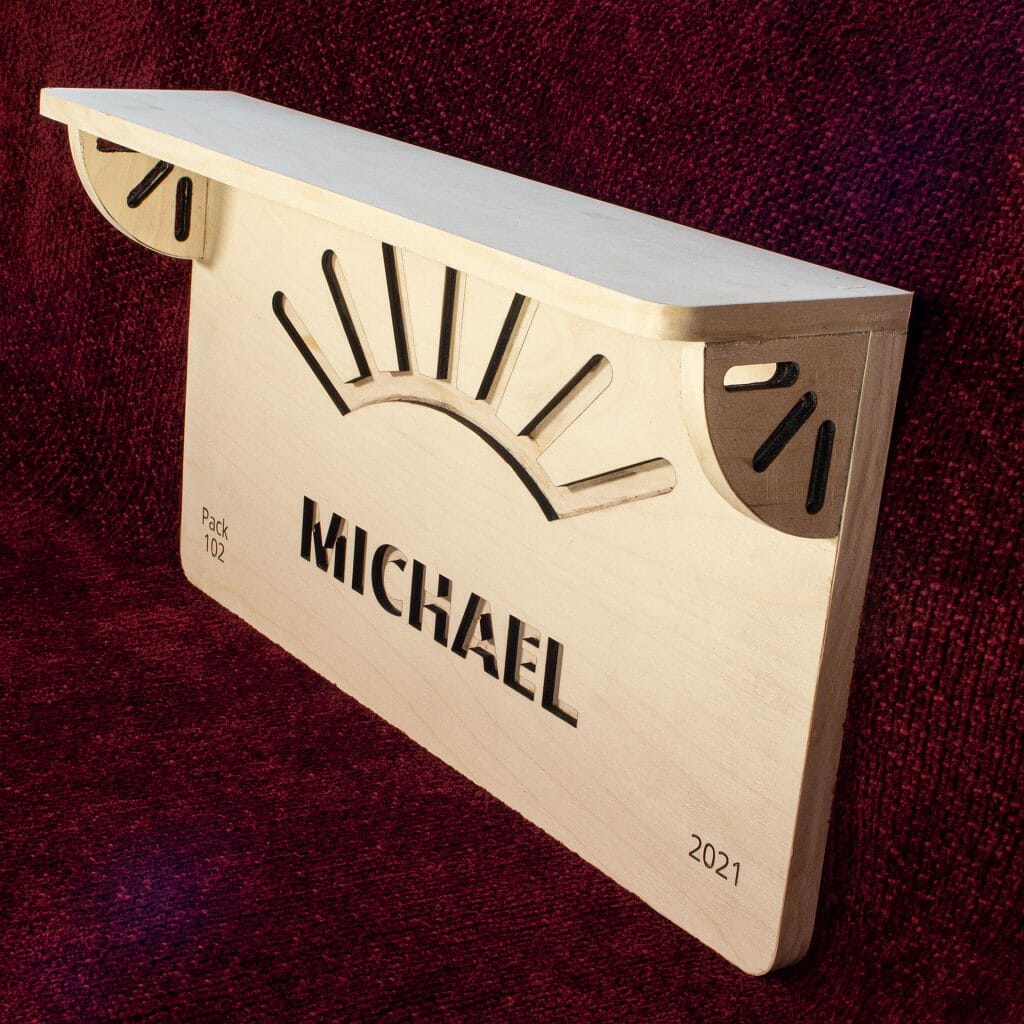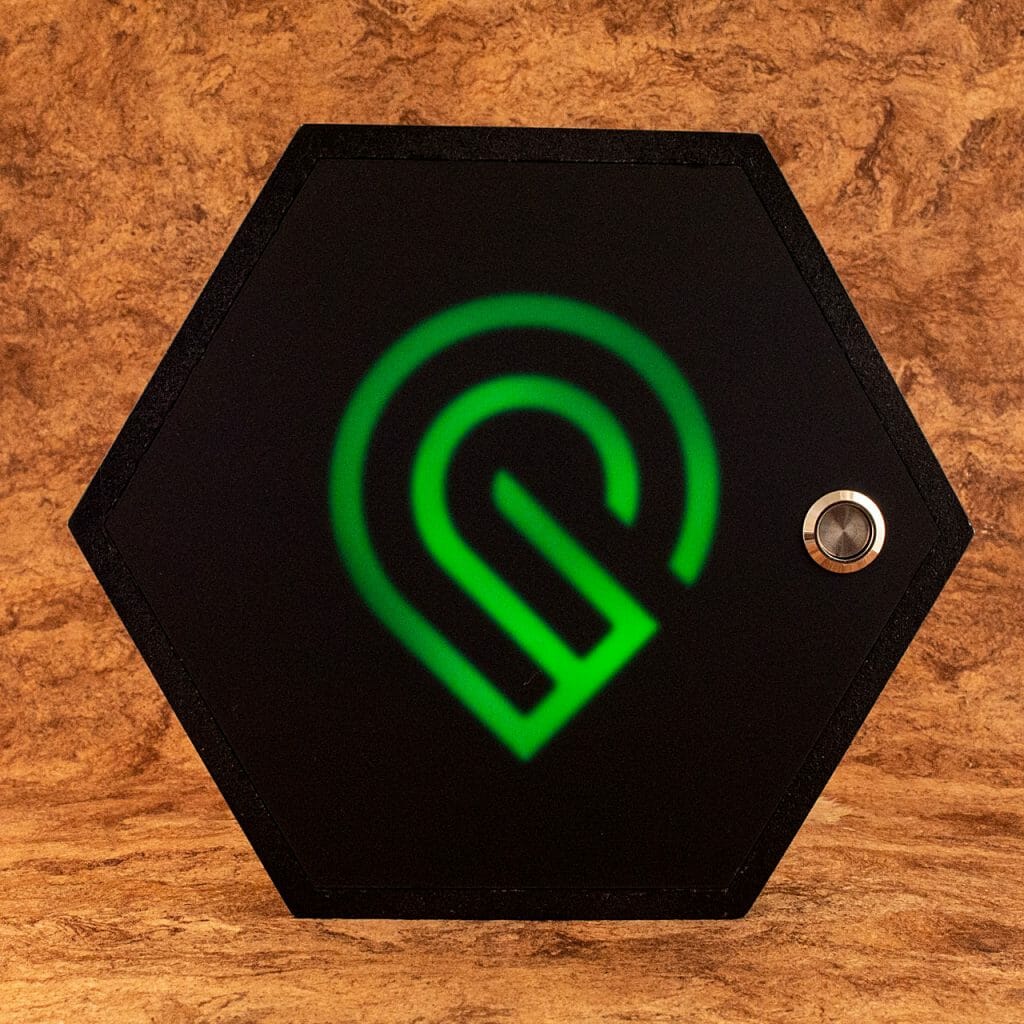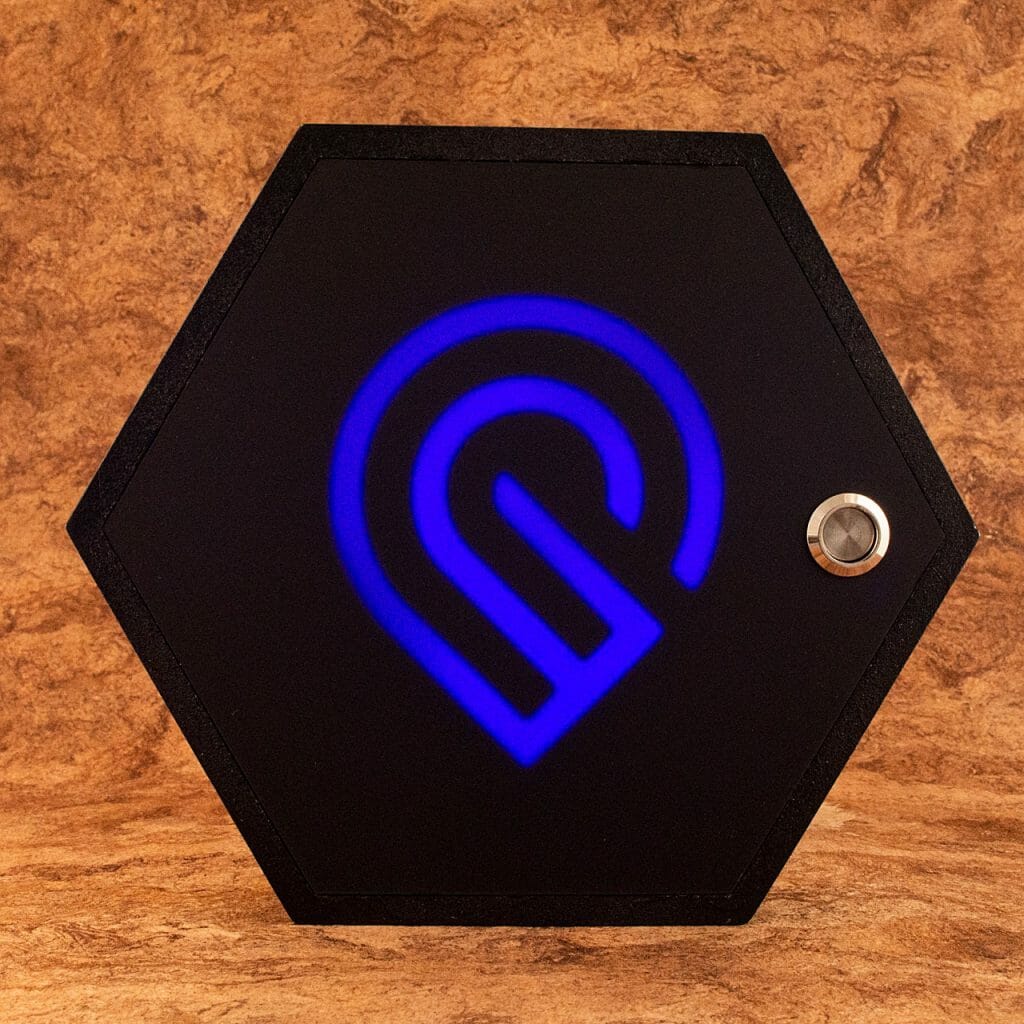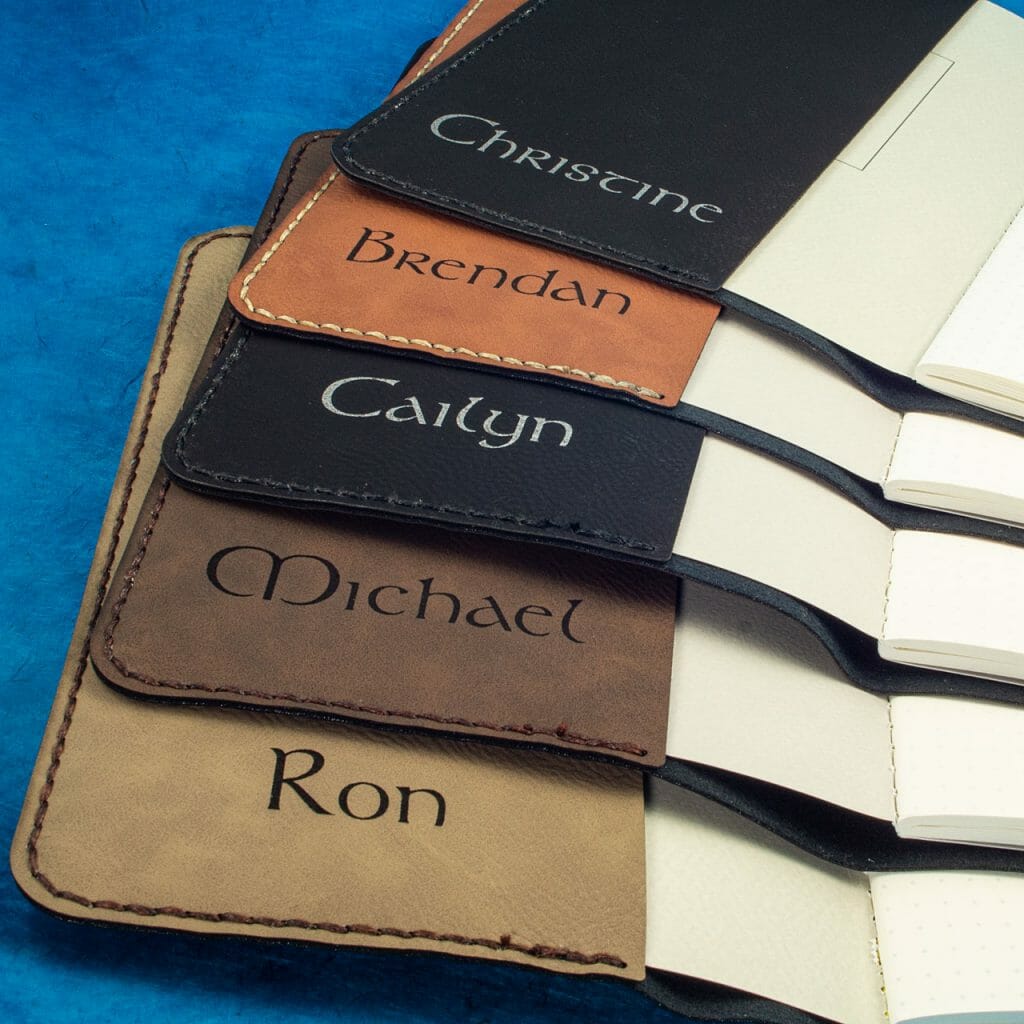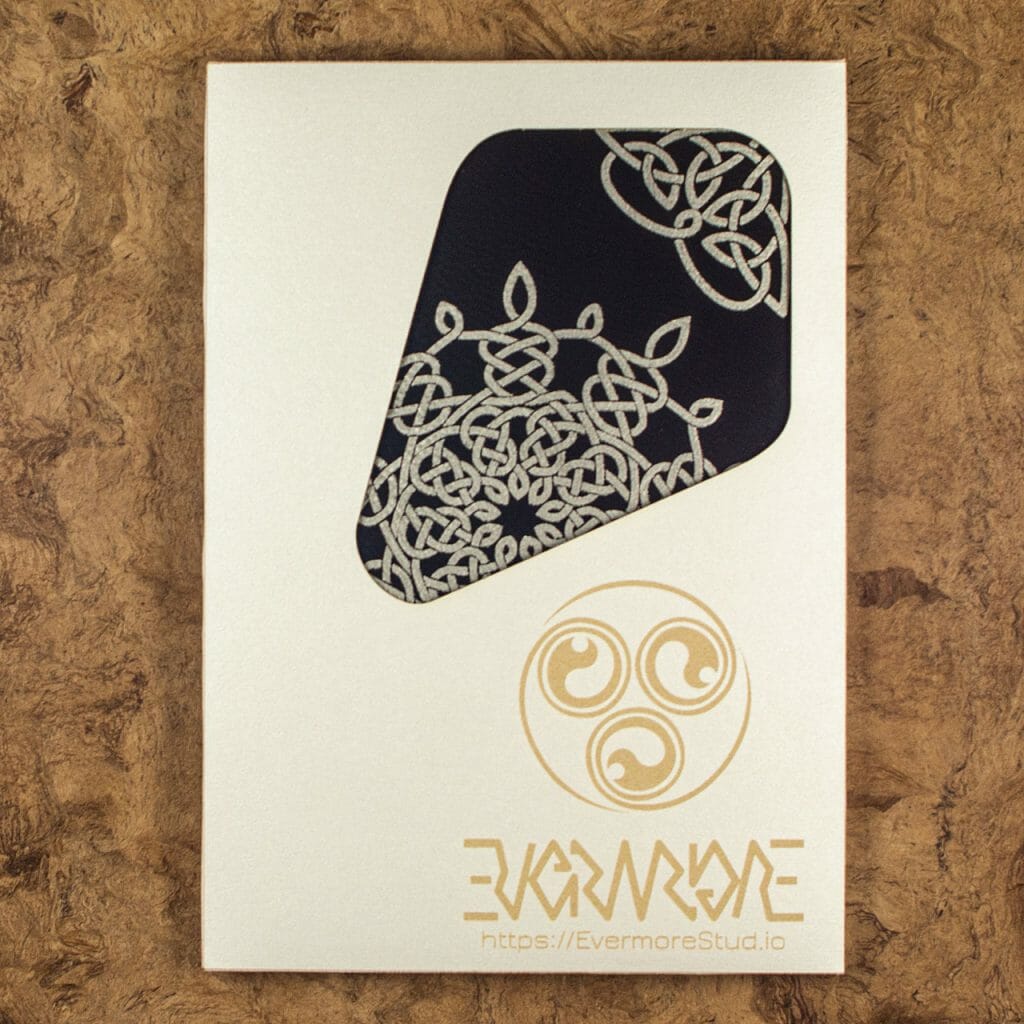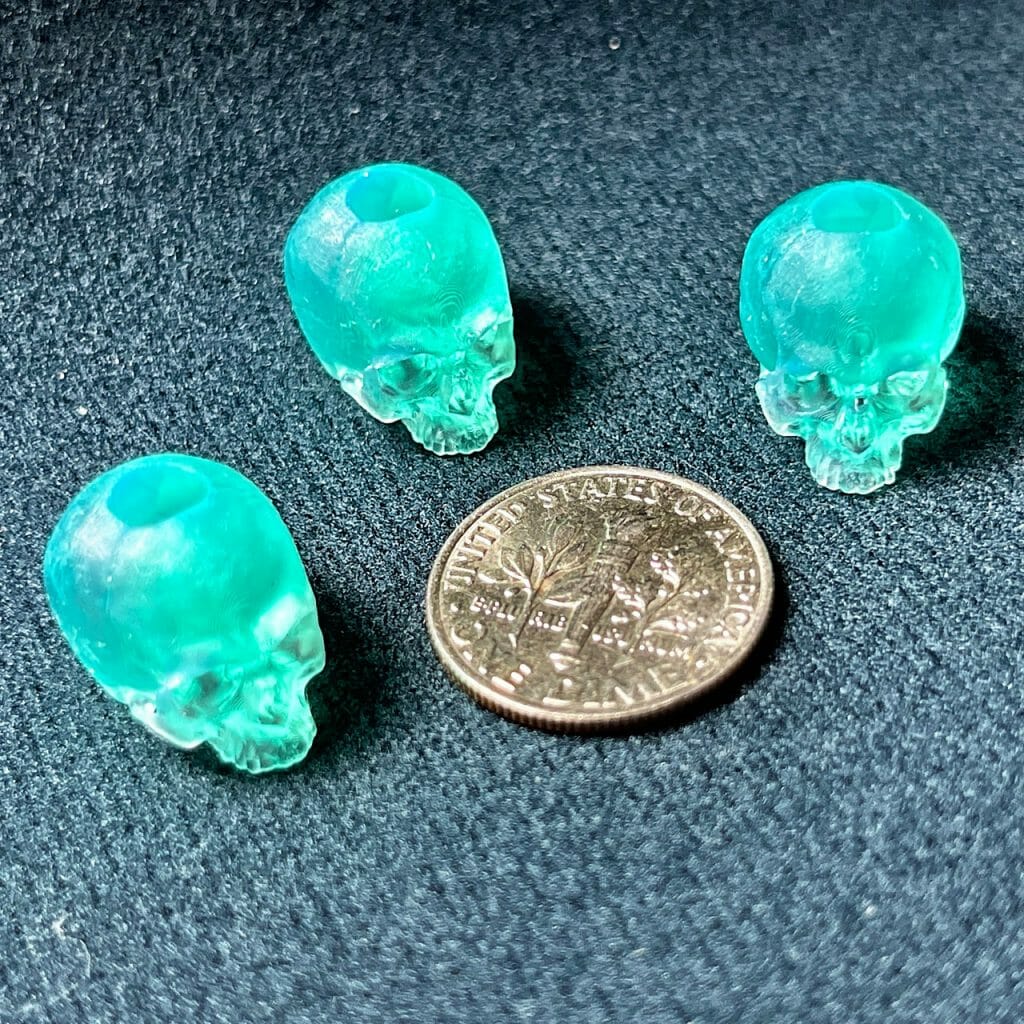Personalized Arrow of Light Shelf Plaque

A recent recipient of the Arrow of Light wanted a plaque + shelf to hang in his room for display. There didn’t seem to be anything easily available that fit the bill. So, despite limited experience with woodworking, I agreed to take a run at it.
I did a quick visualization in Fusion 360 but, patterned the parts in Inkscape.
The back is three layers of 1/4″ Baltic birch plywood glued together. The name and sunbeam design are cut through the top layer with additional details engraved in the corners. I put cut-outs in the back layer so the hardware can be inset and, allow for flush mounting against a wall.
The shelf and brackets are two layers of the same plywood, laminated with glue.
My original intent was to use countersunk screws to connect the bottom layer of the shelf to the plaque, then put the second shelf layer over that to create a good mechanical connection. With all of my countersink bits MIA, though, I ended up just using wood glue. A few quick tests suggest the ply will fail before the glue does.
I applied birch edge banding – my first experience with edge banding – to all of the exposed edges for a more consistent look.
This was shipped unfinished so that the recipient can stain it himself to match his room decor.
Make Your Own Arrow of Light Plaque Shelf
If you want to make a plaque + shelf like this, the files are below. Note that there are two files, one for the plaque part and another for the shelf.
The font I used is Open Sans Extrabold (link goes to download) at 144pts. I left it as text in the file. When you have the text/name you want, use the alignment tool in your editing software (e.g., Inkscape) to center it on the sunburst. Then, convert the text to paths (Path > Object to Path in Inkscape).
Similarly, edit the text in the corners as desired, then convert them. Leave them filled to process them as engraves.
Cut three variants of the plaque:
- The front layer with the corner text engraved and the name, sunburst and outline cut out (everything else ignored).
- The middle layer with just the two clusters of three tiny screw holes and the outline.
- The back layer with the cut-outs for the mounting hardware and the outline.
Laminate the three layers together with wood glue, avoiding applying glue to areas that will be exposed.
The shelf is simpler: cut two shelf pieces and four bracket pieces and laminate each set of two together with wood glue.
Glue the shelf and brackets to the plaque as seen in the photos. Edge band, if desired.
Finish (e.g., stain, paint), install the mounting hardware, add the arrow and hang.
Materials
You are almost certainly better off buying your Baltic birch plywood from a local supplier. You can get little boxes of it online but, it is generally twice the price.
1/4″ Baltic Birch Plywood (Amazon)
Amazon referral links for some parts and incidentals defray IT and hosting costs for a local arts organization (Arizona Aikido).
Design Files
These files are for personal, non-commercial use only. If you want to produce these to sell or for other business use, please contact me to arrange for licensing terms. Also note that, by referencing these, you are agreeing to release any variations you create under identical terms.
Color-Cycling Glowforge Logo Hex Panel
After a very successful Glowforge forum Regular community build of a pentagonal hexecontrahedron last year, we decided to do another community build this year. For this year’s project, we all contributed hexagonal panels intended for a reconfigurable wall art installation. My piece projects a color-cycling Glowforge logo through a layer of LED-translucent black acrylic. Here is a gallery of images with the colors in various states and, a video showing how I made it.
Quick Paper Towel Roll Holder

After one too many rounds of fumbling with a roll of paper towels while working at the resin 3D printer, I whipped out this quick paper towel roll holder. It’s a laser-cut strip of quarter-inch-thick acrylic, a three-quarter inch dowel I had on-hand and, a couple discs of MDF. It drops into the wire rack I am using as a 3D printing workstation. There are screw holes for mounting, if someone wanted to put it somewhere like under a cabinet.
Sandwich either side of each bend point in the acrylic between small pieces of MDF or plywood to constrain the bend to a straight line. Heat with a heat gun and, bend both ends 90 degrees in the same direction.
Cut the dowel to 11.5 inches. Sand a little, if desired. Glue the discs on the ends and, allow to dry.
The dowel goes through the tube of the paper towel roll, then drops in to the slots.
Here is a fast (and quiet) assembly video if you prefer to see it done:
It’s a quick and dirty design with many opportunities for improvement but, here is the design file, in case it is useful to anyone.
Design Files
These files are for personal, non-commercial use only. If you want to produce these to sell or for other business use, please contact me to arrange for licensing terms. Also note that, by referencing these, you are agreeing to release any variations you create under identical terms.
Celtic Key Pattern Embossed Velvet
With a new couch on the way last year, I came up with a plan to create some unique thematic throw pillows to go on it. In addition to one made from a fine wool Crawford clan tartan, I envisioned one of a forest green velvet embossed with one of my key pattern designs.
I figured that some combination of heat, pressure and a rigid die/stamp/form would give me what I wanted. I tracked down some (100% polyester upholstery) velvet, ordered samples and, made a test form on the laser from 1/8″ thick MDF. I cut a key square and, experimented using my old heat press.
After some experimenting (on purple velvet, while waiting on the green), I was able to find an approach that works. I set the pressure on the heat press by putting in a single sheet of 1/8″ MDF, tightening down until it touched the board, then adding another quarter turn. The range of pressure that works is pretty narrow. Too little pressure and the resulting design is faint. Too much pressure and, you emboss the edges of the form’s base, too.
The form goes on the bottom platen, facing up. The velvet goes on the form, facing down. I mist the back of the velvet lightly with a little water so there will be a little steam (but not enough to spot the fabric).
The optimal heat seems to be about 400º F for about 15 seconds.
I broke out my vintage Elna Supermatic sewing machine and, turned some of it into a pillow. I did several extra pieces. So, look for it in future projects.
There is a full video walk-through of making the forms and the embossing and, a separate video showing off the sewing machine and making the pillow.
Celtic Knotwork Journal
These journal covers are engraved with my Snowflake Celtic knotwork design (and a new corner piece I designed specifically for these). These are laser-cut and engraved, then saddle stitched by hand (using the stitching pony I made recently). These are made from a synthetic/vegan leather that looks and feel impressively like real leather. I personalized a few of them. These slip onto the Baron Fig Vanguard notebooks, which can be easily swapped as notebooks are filled.
I also made some packaging for them. The Ice Gold cover stock laser engraves in a nice metallic gold for the design and ambigram logo.
Update: These are now available in the shop!
Skull Beads
I used some hand-carved cow bone skull beads in a recent (forthcoming) project. I like the look there but, they are pretty rough. Someone was showing me some tiny hand-carved wooden skull beads and, I wondered if I could come up with some relatively easy way to produce some more detailed skull beads. My under-used SLA resin printer seemed like a good option.
I created a remix of a full skull model by Arminas Didziokas. I used MeshMixer to remove the lower jaw, make it solid and, put a hole through it. I printed a few at different sizes to get a feel for what would be best.
After curing, I primed them with Montana Cans white primer. When that was dry, I dug out my old Aztek 3000S airbrush and gave them a coat of something more of an aged bone color. Next, I did a simple dark brown wash on two of them them and, a black wash on the other. They then got a light coat of matte polyurethane to protect the paint.
The holes probably need to be somewhere around .5-1mm smaller and, my painting technique needs some work. It was challenging getting the wash to stay everywhere I wanted it and, the highlights got muddier than I would prefer. Overall, though, I think they look pretty good.
Another possibility for future attempts would be to use the 3D prints to cast these in something else.
Note the dime in the scale pic. These are a little under 1cm wide.







